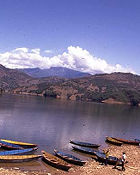Water, sanitation and hygiene have important impacts on both health and disease.
Water-related diseases kill a child every 8 seconds, and are responsible for 80% of all illnesses and deaths in the developing world.

Water-related diseases kill more than 5 million people every year, more than ten times the number killed in wars.
Arsenicosis is caused by long-term exposure to low concentrations of arsenic in drinking-water. It causes painful skin keratosis (hardened lesions) and can result in cancers of the skin, lungs, bladder and kidney. Millions of people are potentially in danger from arsenic poisoning since the water supplies they rely on are contaminated with arsenic (mainly from natural sources) and they either do not have a safe alternative for water supply or are unaware of the risks.
Cholera is an acute bacterial infection of the intestinal tract. It causes severe diarrhoea attacks that, if they are not treated adequately, can quickly lead to acute dehydration and death. Cholera is a world-wide problem that could be prevented by providing access to safe drinking water, sanitation and good hygiene behaviour (including food hygiene). In 2002, over 120,000 cholera cases were reported worldwide.
Diarrhoea is caused by a variety of micro-organisms including viruses, bacteria and protozoans. It causes a person to lose both water and electrolytes, which leads to dehydration and, in some cases, to death. About 4 billion cases of diarrhoea per year cause 1.8 million deaths, over 90% of them (1.6 million) among children under five.
Fluorosis is a serious bone disease caused by high concentrations of fluoride occurring naturally in groundwater. It is endemic in at least 25 countries across the globe. The total number of people affected is not known, but a conservative estimate would number in the tens of millions.
People contract guinea worm disease (also known as Dracunculiasis) when drinking water contaminated with Dracunculus larvae. The larvae mature into large (up to a metre long) adult Guinea worms and leave the human host’s body after about a year, causing debilitating ulcers. In 2002 there were 50,000 cases reported in a total of 13 countries in Africa.
People become infected with intestinal parasitic worms (also know as helminths) through contact with soil contaminated with human faeces from an infected person, or by eating contaminated food. Intestinal worms infect about 10% of the population in the developing world and, depending upon the severity of the infection, lead to malnutrition, anaemia or retarded growth. About 400 million school-age children are infected by roundworm, whipworm and/or hookworm.
Malaria is caused by a parasite carried by certain types of mosquitoes. Humans are infected when bitten by the mosquitoes. Each year, there are 300 million to 500 million cases of malaria throughout the world and about 1 million children die of malaria. Reducing the mosquito population in households and communities by eliminating standing water can be an important factor in reducing malaria cases.
Schistosomiasis (also known as bilharzia) is a disease caused by parasitic worms. At various stages of the life cycle, worms and their eggs live in certain types of freshwater snails, water (where they can survive for up to 48 hours) and human hosts. They penetrate the skin of people swimming or washing in contaminated water; they then cause infection and can eventually damage the liver, intestines, lungs and bladder. About 200 million people are infected with schistosomiasis. Studies have found that adequate water supply and sanitation could reduce infection rates by 77%.
Trachoma is an eye infection spread mainly through poor hygiene caused by lack of adequate water supplies and unsafe environmental sanitation conditions. About 6 million people are blind today because of trachoma. It affects women two to three times more than men. Children are also especially vulnerable to trachoma. Studies have found that providing adequate water supplies could reduce infection rates by 25%.
Typhoid fever is a bacterial infection caused by ingesting contaminated food or water. Symptoms are characterized by headaches, nausea and loss of appetite. About 12 million people are affected by typhoid every year.
Information from:
the ‘Common water and sanitation-related diseases’ section of the United Nations Children’s Fund (UNICEF) website
the World Health Organization’s (WHO) ‘Water and sanitation related diseases fact sheets’
Source: UNESCO Water Portal, October 2006

